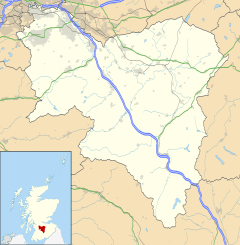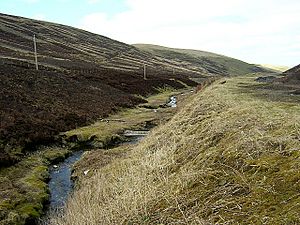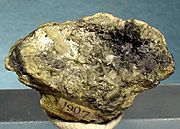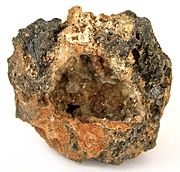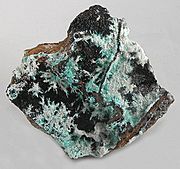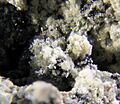Leadhills facts for kids
Quick facts for kids Leadhills |
|
|---|---|
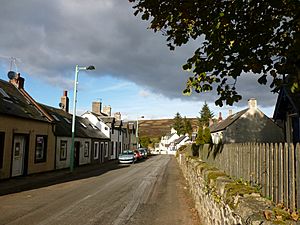 Main Street, Leadhills |
|
| Population | 315 |
| OS grid reference | NS885150 |
| Council area | |
| Lieutenancy area | |
| Country | Scotland |
| Sovereign state | United Kingdom |
| Post town | Biggar |
| Postcode district | ML12 |
| Police | Strathclyde |
| Fire | Strathclyde |
| Ambulance | Scottish |
| EU Parliament | Scotland |
| UK Parliament |
|
| Scottish Parliament | |
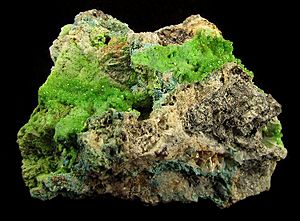
Leadhills is a small village in South Lanarkshire, Scotland. It was first built to house miners. The village is about 5+3⁄4 miles (9.3 km) west-southwest of Elvanfoot. In 1901, about 835 people lived here. It was originally called Waterhead.
Leadhills is the second highest village in Scotland. Its neighbour, Wanlockhead, about 2 miles (3 kilometres) south, is the highest. The village is close to where the Glengonnar Water begins. This water is a tributary (a smaller river that flows into a larger one) of the famous River Clyde.
Contents
Fun Things to Do in Leadhills
Leadhills Miners' Library
The Leadhills Miners' Library is a very old and special place. It was started in 1741 by 21 miners, the local schoolteacher, and the local minister. They wanted to buy books for everyone to learn and improve themselves. Even people who weren't miners could join.
This library is the oldest subscription library in the British Isles. It has many old books, local treasures, mining records, and minerals. People who visited the library in the past said the miners were very smart and could talk about history, science, and even politics. They had lots of time to read because they only worked a few hours a day in the mines.
Today, a charity called The Leadhills Heritage Trust runs the library. It is open from Easter to September on weekends and bank holidays, usually from 2 PM to 5 PM.
Grouse Moors
Around Leadhills, there are huge areas of land called grouse moors. These cover more than 11,000 acres (45 km2). They are important places where grouse (a type of bird) live.
Leadhills Golf Course
The Leadhills Golf Club started in 1891. It is the highest golf course in Scotland! The course has nine holes and can be quite tricky because of the strong, changing winds that blow between the hills.
The club was first called Leadhills Golf Club. After World War 1, it was renamed Lowthers Golf Club, but in 1935, it went back to its original name. The current club was officially founded in 1935.
Grave of John Taylor
You can visit the grave of John Taylor in the village cemetery. People say he was 137 years old when he died! His grave is shared with his son, Robert. This old story even caught the attention of the BBC.
Scots Mining Company House
The Scots Mining Company House was built in 1736. It was made for James Stirling, who managed the Scots Mining Company. It's believed that a famous architect named William Adam designed it. Today, it's a very important historic building.
Leadhills and Wanlockhead Railway
The Leadhills and Wanlockhead Railway is a fun heritage railway that runs on weekends. Around Christmas, they have a special "Santa Express." This includes a train ride, a visit to Santa in the old lead mine, and a story from "Mrs Kringle" at the Museum of Lead Mining in Wanlockhead. The railway is about 1,498 feet (457 m) above sea level.
Lowther Hills Ski Centre
The Lowther Hills area is one of the places where Scottish winter sports began. People have been curling in Leadhills since 1784! The Leadhills Curling Club was one of the first curling groups in Scotland. Curling was popular here until the mines closed in the 1930s.
Since the 1920s, skiing has also been popular in the Leadhills area. Lowther Hill, which is above the village, has the only ski area in the south of Scotland. It's also Scotland's only community-owned ski centre. The Lowther Hills Ski Club runs three ski lifts for beginners and intermediate skiers.
Local Businesses
Leadhills has several small local businesses, including shops and a hotel.
Geology and Minerals
Gold, Silver, and Lead Mining
Silver and lead have been mined in Leadhills and nearby Wanlockhead for many centuries. Some people even think mining happened here during Roman times!
Gold was found in the area during the time of King James IV. Back then, the gold was so pure and famous that the whole area was called "God's Treasure House in Scotland." In the 1500s, before all the easy-to-find gold was gone, hundreds of men worked here. They found a huge amount of gold, which would be worth hundreds of millions of pounds today! Much of the gold used for coins by King James V and Mary Queen of Scots came from Leadhills.
After 1620, there wasn't much commercial gold mining. However, people still looked for gold by "panning" (washing river gravel) in the area. You can still pan for gold here today if you have the right licence.
Unique Minerals
Leadhills is famous among scientists who study minerals (mineralogists) and geologists. Many unique minerals were first discovered here. These include lanarkite, leadhillite, caledonite, susannite, plattnerite, scotlandite, macphersonite, chenite, and mattheddleite. The area is known for having a wide variety of different minerals found deep inside the old mine shafts.
Leadhills Supergroup
The village also gives its name to a huge geological feature called the Leadhills Supergroup. This is one of the large rock formations found in the British Isles.
Mining History
In the 1500s, mining in Leadhills was run by landowners, goldsmiths, and metal experts. They were given special permission by the king and the Privy Council of Scotland. In the 1700s, lead ore from Leadhills was sent to Holland to make white and red paint.
Working Conditions in the Mines
Life for miners in Leadhills was very tough. The landscape around the mines was described as "barren and gloomy." The air in the mines was often bad. Miners and smelters (people who melted the lead) could get sick from "mill-reek," which caused problems like shaking and sometimes even madness. Animals in the area also got sick from lead poisoning.
However, because lead was in high demand during wars and a building boom, the Leadhills lead mines became very famous around the world.
How Miners Worked
Unlike many workers today, Leadhills miners in the early 1800s didn't get paid a daily wage. They lived rent-free and worked no more than six hours a day, with no fixed working hours.
Miners worked in small groups called "partnerships," usually up to 12 people. They were paid as a group based on a "bargain" (a contract) to do a specific job for an agreed price. This meant they were paid for the results of their work, not for the time they spent underground.
There were two main types of work:
- "Tut-work" or "fathom work": This was for jobs that didn't give immediate lead, like digging shafts or tunnels. They were paid a fixed amount for a certain length.
- "Tribute work": This was for bringing the lead ore to the surface. They were paid based on the total weight of the ore they found.
Miners' families also helped out. Sons would wash impurities from the ore outside, and wives and daughters would spin wool or embroider cloth to sell. The miners had to supply and look after their own tools. Because the miners were responsible for their own work and safety, only a few overseers were needed for hundreds of miners.
Steam Engines in the Mines
Coal-fired steam engines were very important for mining in Leadhills. As early as 1778, Leadhills had three steam engines. These engines helped pump water out of the deep mines.
1817 Mining Accident
On March 1, 1817, a terrible accident happened in the mine. Noxious fumes (bad gases) from a faulty chimney of a steam engine, combined with a thick fog, filled the mine. The air became deadly.
Four men went into the mine early, hoping to finish quickly. They breathed the bad air, became dizzy, collapsed, and sadly died. Later, three more men at a deeper level also died when the fumes spread. Many other miners became sick but were helped by the mine's surgeon, James Braid.
Cemetery
The cemetery is located at the northeast of the village. It has an unusual gravestone (a "table-stone") that mentions John Taylor, who was said to be 137 years old when he died. He was the father of Robert Taylor, who was an overseer for the Scotch Mining Company.
Near the cemetery, there is a memorial built in 1891 for William Symington, who was born in Leadhills. It's shaped like an obelisk (a tall, four-sided pillar).
Famous People from Leadhills
Several notable people were born or lived in Leadhills:
- Allan Ramsay, a famous poet.
- William Symington (1763–1831), who was one of the first people to use steam engines to power boats.
- The famous mathematician James Stirling worked for the Scots Mining Company in Leadhills from 1734 to 1770.
- James Braid, who later discovered hypnotism, was a surgeon for the Leadhills mining community from 1816 to 1825.
- Edward Whigham, a local leader from Sanquhar and a friend of the poet Robert Burns, was also born here.
Climate
Leadhills has a cool, wet climate. Because it's high up and inland, winters are colder and summers are cooler than in lower areas. Leadhills is one of the coldest places in the British Isles. In fact, it's the second coldest village in the UK (among those with weather stations), with an average yearly temperature of 6.76 °C (44.17 °F). This makes it slightly colder than Braemar, which is often thought of as the coldest place.
| Climate data for Leadhills: 393m (1991–2020 normals; extremes 1959–2020) | |||||||||||||
|---|---|---|---|---|---|---|---|---|---|---|---|---|---|
| Month | Jan | Feb | Mar | Apr | May | Jun | Jul | Aug | Sep | Oct | Nov | Dec | Year |
| Record high °C (°F) | 10.9 (51.6) |
13.2 (55.8) |
19.5 (67.1) |
23.8 (74.8) |
26.8 (80.2) |
28.2 (82.8) |
28.4 (83.1) |
28.5 (83.3) |
24.8 (76.6) |
21.7 (71.1) |
14.6 (58.3) |
12.8 (55.0) |
28.5 (83.3) |
| Mean daily maximum °C (°F) | 4.5 (40.1) |
4.9 (40.8) |
7.0 (44.6) |
9.8 (49.6) |
13.4 (56.1) |
15.5 (59.9) |
17.3 (63.1) |
16.7 (62.1) |
14.3 (57.7) |
10.4 (50.7) |
7.0 (44.6) |
4.9 (40.8) |
10.5 (50.8) |
| Daily mean °C (°F) | 1.9 (35.4) |
2.1 (35.8) |
3.7 (38.7) |
5.8 (42.4) |
8.7 (47.7) |
11.2 (52.2) |
13.1 (55.6) |
12.7 (54.9) |
10.7 (51.3) |
7.3 (45.1) |
4.3 (39.7) |
2.3 (36.1) |
7.0 (44.6) |
| Mean daily minimum °C (°F) | −0.6 (30.9) |
−0.8 (30.6) |
0.2 (32.4) |
1.8 (35.2) |
4.0 (39.2) |
6.9 (44.4) |
8.9 (48.0) |
8.6 (47.5) |
6.9 (44.4) |
4.2 (39.6) |
1.5 (34.7) |
−0.5 (31.1) |
3.4 (38.2) |
| Record low °C (°F) | −14.1 (6.6) |
−14.0 (6.8) |
−15.0 (5.0) |
−9.4 (15.1) |
−6.8 (19.8) |
−3.1 (26.4) |
0.0 (32.0) |
−1.1 (30.0) |
−3.4 (25.9) |
−7.4 (18.7) |
−10.5 (13.1) |
−15.0 (5.0) |
−15.0 (5.0) |
| Average precipitation mm (inches) | 217.5 (8.56) |
166.8 (6.57) |
149.3 (5.88) |
114.1 (4.49) |
109.0 (4.29) |
104.1 (4.10) |
122.2 (4.81) |
140.5 (5.53) |
142.3 (5.60) |
201.8 (7.94) |
207.0 (8.15) |
212.7 (8.37) |
1,887.3 (74.29) |
| Average precipitation days | 20.0 | 16.8 | 16.5 | 14.9 | 13.6 | 13.8 | 16.2 | 16.4 | 15.8 | 18.9 | 19.0 | 18.9 | 200.8 |
| Source 1: Météo Climat | |||||||||||||
| Source 2: Météo Climat | |||||||||||||
Images for kids


